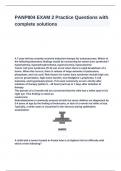PANP804 EXAM 2 Practice Questions with
complete solutions
A 7-year-old has recently received induction therapy for osteosarcoma. Which of
the following laboratory findings would be concerning for tumor lysis syndrome?
hyperkalemia, hyperphosphostemia, hyperuricemia, hypocalcemia
Tumor cell lysis syndrome (TLS) can occur when there is rapid breakdown of a
tumor. When this occurs, there is release of large amounts of potassium,
phosphate, and uric acid. Risk factors for tumor lysis syndrome include high uric
acid on presentation, high tumor burden, non-Hodgkins' Lymphoma, T-cell
leukemia, and hyperleukocytosis. TLS most commonly occurs shortly after
initiation of therapy (within 6 – 48 hours) and up to 7 days after initiation of
therapy.
The parents of a 3-month-old are concerned that the child has a white spot in his
right eye. This finding is noted as:
Leukocoria
Retinoblastoma is commonly present at birth but most children are diagnosed by
3-4 years of age by the finding of leukocoria, or lack of a nornal red reflex of eye.
Typically, a white mass is visualized in the vitreous during ophthalmic
examination.
Previous
Play
Next
Rewind 10 seconds
Move forward 10 seconds
Unmute
0:00
/
0:15
Full screen
Brainpower
Read More
A child with a tumor located in frontal lobe is at highest risk for difficulty with
which of the following?
,A. Thought/memory/motor movements
B. Vision/hearing/smell
C. Language/heart rate/temperature
D. Oculomotor movement/anger/proprioception
A. Thought/memory/motor movementsThe frontal lobe of the brain is often
considered the area where higher functioning of judgment, memory, and thought
occur. This area is also associated with the origination of motor movement.
Which electrolyte derangements may be noted in a child requiring a massive
transfusion of packed red blood cells?
Hypocalcemia and hyperkalemia
There are several side effects of massive blood transfusion. Hypocalcemia is
often noted from citrate required to store the blood product and hyperkalemia
from potassium leakage from the stored red blood cells. Coagulopathy
(dilutional), hypothermia, and risk for transfusion associated lung injury (TRALI)
are additional risks of massive transfusion therapy.
Anemia associated with _______________ is most likely when presence of
jaundice is noted on examination?
Hemolysis
Hemolysis and break down of red blood cells is commonly associated with
schistocytes on the blood smear and jaundice on examination.
A previously healthy 4-year-old child presents with fever, abdominal pain, pallor,
petechiae, hematuria, oliguria, azotemia, and watery diarrhea that progress to
hemorrhagic colitis. The stool culture will most likely be positive for:
E. coli 0157:H7
Hemolytic uremia syndrome (HUS) is a disease of the microcirculation
characterized by hemolytic anemia, thrombocytopenia, and acute renal failure. It
occurs most frequently in children < 4 years of age and is the most common
cause of acute renal failure (ARF). D+HUS, post diarrheal HUS, occurs in
previously healthy children who have had recent gastroenteritis. The mortality
rate is 3%-5%; associated with renal failure in 50% to 70% of patients affected.
HUS diagnosis is supported by patient history and the presence of
microangiopathic hemolytic anemia, thrombocytopenia, and acute renal failure.
Laboratory findings associated with D+HUS include reticulocytosis and abnormal
RBC morphology, shistocytes, burr and helmet cells on smear; fragmented
erythrocytes, anemia, decreased haptoglobin, thrombocytopenia, leukocytosis,
abnornal coagulation, Coombs negative, and stool cultures are often positive for
E. Coli 0157:H7. Microscopic hematuria and proteinuria are common on
urinalysis.
Which of the following work up is necessary for a 2-month-old who was born at
34 weeks gestation and presents with fever to 102.3°F rectally with reported mild
cough for 24 hours?
, A. CBC with differential and blood culture
B. CBC with differential, blood culture, urine culture, and chest radiograph
C. Chest radiograph first and if negative then obtain labwork for sepsis
D. CBC with differential, blood and urine cultures, chest radiograph, and lumbar
puncture
D. CBC with differential, blood and urine cultures, chest radiograph, and lumbar
puncture
According to the American Academy of Pediatrics (AAP) practice guidelines for
infants < 2 months of age with fever require a full sepsis work up which includes
CBC with differential, blood and urine culture, chest radiograph, and lumbar
puncture. Other diagnostic studies can be added based on presentation.
Which of the following is the rationale for using Hydroxyurea followed by its
mechanism of action?
A. Sickle cell anemia; Increasing fetal hemoglobin and reducing leukocytes and
reticulocytes that contribute to vaso-occlusion.
B. Thalassemia; Increasing fetal hemoglobin and reducing leukocytes and
reticulocytes that contribute to vaso-occlusion
C. Sickle cell anemia; Decreasing presence of fetal hemoglobin which reduces
the incidence of sickled red blood cells
D. Thalassemia; Decreasing presence of fetal hemoglobin which reduces the
incidence of sickled red blood cells
A. Sickle cell anemia; Increasing fetal hemoglobin and reducing leukocytes and
reticulocytes that contribute to vaso-occlusion.
Hydroxyurea is classified as an antimetabolite with a generally unknown
mechanism of action. The medication inhibits ribonucleotide reductase
immediately inhibiting DNA synthesis. In children with sickle cell anemia,
hydroxyurea increases fetal hemoglobin levels and RBC water content, thus
improving sickled cell deformability. It is also known to reduce the presence of
leukocytes and reticulocytes that would contribute to vaso-occlusion.
A 3-year-old female presents with a 4 day history of abdominal pain, nausea,
vomiting, diarrhea, and fever, with temperatures over 102°F. The child had eaten
at fast food restaurants twice in the past 2 weeks, but no one else at home is ill.
Initial laboratory evaluation: Na 126 mEq/L, K+4.5 mEq/L, Cl 105 mEq/L, CO2 13
mEq/L, BUN 100 mg/dL Cr 2.1 mg/dL, Glucose 90 mg/dL, WBC 25,000
cells/mcl ,Hemoglobin 8.7 g/dL, Hematocrit 23%, platelets 90,000 cells/mcL;
prothrombin time 12, INR 1.2, APTT 26, Fibrinogen 250 mg/dL; peripheral smear
indicates + schistocytes. What is the most likely diagnosis?
A. Hemolytic uremic syndrome (HUS)
B. Gastroenteritis
C. Urinary tract infection
D. Intussusception




